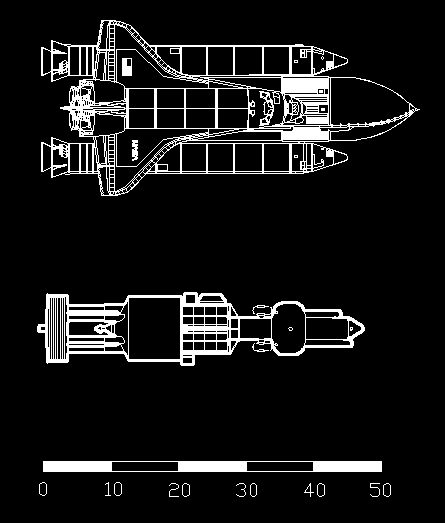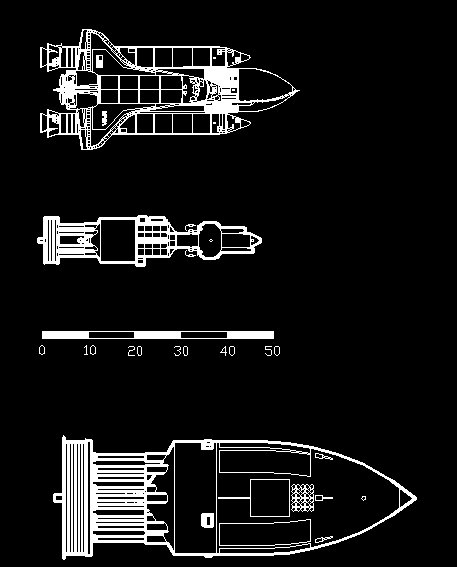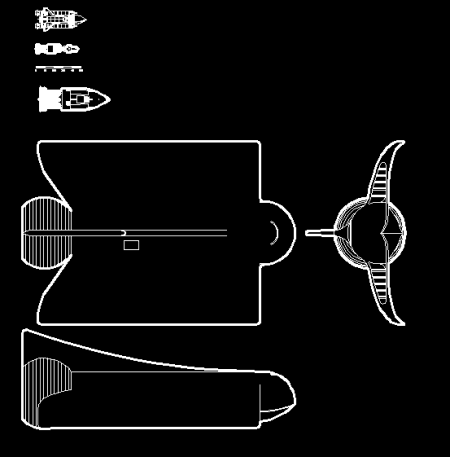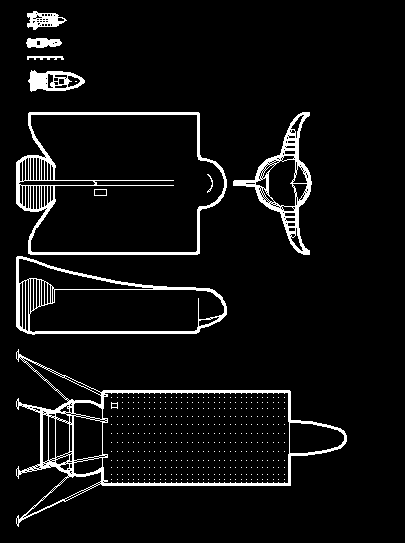Something I’ve long noticed is that when someone in the aerospace world – as opposed to science fiction (author or fanboy) – envisions a truly large spacecraft, it’s almost always powered by some form of nuclear pulse propulsion. Whether it’s driven by dirty A-bombs, cleaner H-bombs, really clean pure fusion devices or far-futuristic anti-matter initiated fusion detonations, the fact seems to be that discrete detonations of nuclear pulse units seems to be the way to go. In contrast, theoretically “better” propulsion systems like steady-state fusion or fusion-free antimatter reactions tend to have fewer designs for really large vehicles. A few designs like various laser/maser sails and the”Valkyrie”-type starship are non-nuke pulse designs, but they seem to be the exception.
In support of my “Nuclear Pulse Propulsion” book, I’m working on a whole bunch of layout drawings. They are all being sized to fit on standard C-size sheets; while the book almost certainly won’t be anywhere near that big (your average road atlas ain’t that big), I want them standardized anyway. Each design has its own sheet, at a scale that allows the design to be shown well. But I also have some scale comparison sheets with multiple designs shown side by side.
Tonight I decided to take some of the representative larger vehicles and put them all to scale on one sheet. As will be seen, some people dream *big.*
First… the smallest practical orion, the 10-meter design, next to a Space Shuttle. Even being the smallest design, it’s still really big compared to the usual stuff we’ve bothered to send into space. The C-size drawing for this vehicle is 1/100 scale:
Next, the 4,000 ton “battleship” design. The C-size drawing for this is at 1/250 scale:
From here, the next step is pretty big. The 4,000 ton Orion is the largest design available to me where detailed engineering design work was known to be carried out. The designs that follow tend to be notional… some of them the vague handwavings of aerospace professionals, others carried out at least at the mathematical scale.
Next is the (Martin Co.) Dandrige Cole “Aldebaran” design for a single stage to orbit cargo lifter. Given a poorly described propulsion system that seems to have consisted of an airbreathing nuclear internal-pulse engine, it was vastly larger than the battleship. The C-size drawing is 1/1200 scale.
The next is another Cole design, basically a small free-roaming space colony. The landing gear is to allow it to touch down on asteroids and small moons and such, presumably for exploration and mining operations. The drawing is 1/1500 scale.
Coming soon: Part 2, where Our Hero (that’s me) describes the vehicles that are measured in kilometers. The scales for the C-size drawings for the vehicles to come start at 1/2400 scale and wander on up to 1/600,000 scale. With pulse unit yields measured in “did I read that right? Holy Crap!” units.
Yeah.
11 Responses to “Giants In The Sky: Part 1”
Sorry, the comment form is closed at this time.




It would be fun to see Daedalus and the Enzmann one to that scale also.
I note you put the hatch on top of the Aldebaran for the helicopter to lower things into. I always thought the wings should have had some sort of hydrofoils on their bottoms to help it lift off the water and to keep it from nosing over on landing.
> It would be fun to see Daedalus and the Enzmann
And eventually, you will. Daedalus is on the list to be drawn; it’s just kinda complex and worthy of a lot of detail.
Wait a second…you don’t think those air intakes aren’t related to the aft engine, but rather are to suck in air that then gets ejected out of the wing bottoms to make it hover on a pair of air cushions as it accelerates for takeoff?
Don’t forget this one:
http://www.astronautix.com/lvs/oritsink.htm
Virtually no detail whatsoever on the “heat sink” Orion. It’s 20 km in diameter. That’s all there is.
> you don’t think those air intakes aren’t related to the aft engine, but rather are to suck in air that then gets ejected out of the wing bottoms to make it hover on a pair of air cushions as it accelerates for takeoff?
Too many negatives. I don’t not antithink that the inlets aren’t not for other than not the engine as opposed to against the not underwing hovering sytems. Unless I do. Or don’t.
I keep getting the feeling that there’s something under the waterline that’s not shown in the existing drawings.
I also get the feeling that the main purpose of this design was to “Look Neat” as an illustration, not to actually get built.
There’s a end-on painting of it on this webpage of Project Rho:
http://www.projectrho.com/rocket/rocket3ay.html
It appears basically to be a trimaran planning hull design with the wings forming outriggers.
I don’t see how it’s supposed to lift off the water; the design is more like a giant nuclear-powered speedboat that a spacecraft.
Maybe it’s not a spaceship at all…maybe it’s the fastest ocean liner you ever laid eyes on, and it’s going to race the S.S. United States across the Atlantic to capture The Blue Riband. 😀
The big version of the painting that can be opened on the above webpage reveals further details, including crossed American flags on the bow (see, I told you it’s a racer), a subsidiary cockpit near the top loading hatch in the leading edge of the vertical fin, what may be a door and ladder on the side of the vertical fin, and what may be some sort of giant 30-foot-tall person bred specifically to aid cargo loading walking around near the top hatch.
Also, a complete lack of any sort of aerodynamic control surfaces, making controlling it in atmospheric flight somewhat problematic to say the least.
> I don’t see how it’s supposed to lift off the water
Lots and lots of thrust. With enough of it you don’t need aerodynamics, and this concept had thrust by the kiloton.
I was trying to figure out how it was supposed to angle itself upwards so that the wing got some inclination on it and generated lift.
Near as I can figure, it’s supposed to start rising upwards at the bow like a speedboat as speed picks up, so that air get’s trapped under the wing and the pressure pushes it upwards.
[…] to haul millions of pounds of payload to the lunar surface. I briefly mentioned Aldebaran HERE and HERE. I just stumbled across a piece of Soviet artwork also depicting […]